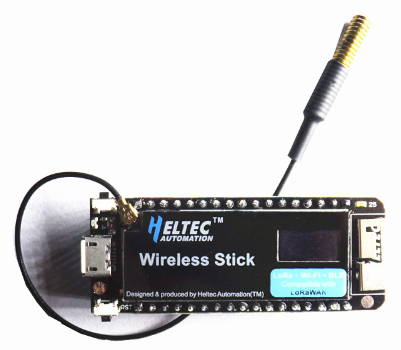There appears to be a new Heltec ESP32 LoRa board:
Heltec Wireless Stick

New features (based on below specs / source):
- Apparently 800uA power consumption in sleep mode.
(Disclaimer: this is my interpretation, formatting on page linked below is not clear about this.)
A major improvement (while still 20+ times more than deep sleep current of ESP32) - 16 MB flash.
- 0.49" OLED display. Yes that’s tiny!
This will probably have 64x32 resolution. - New Wifi Antenna design (similar to TTGO Wifi LoRa32)
(Finally an ESP32 LoRa board with a more properly placed Wifi antenna on top.) - ESP32, LoRa chip and display appear to be shielded with a metal cover (with cutout for display screen).
Processor
Adopt Lexin’s ESP32 chip
- 32-bit dual-core, 240MHz frequency
- Integrated WiFi and Bluetooth
- The main processor is completely free to run the user application.
- An additional ULP coprocessor that monitors GPIOs, ADC channels,
and controls most of the internal peripherals.
LoRa
Using Semtech’s SX1276 chip
- Supports 433MHz, 470MHz, 868MHz, 915MHz quad-band optional
Can be used as both a LoRa node and a micro gateway - Support LoRaWAN protocol
Node transmission distance: up to 6KM in open space - Output power: up to +20dBm (±2dBm)
WiFi
- 802.11 b/g/n/e/i
802 802.11 n (2.4GHz), speed up to 150Mbps
802 802.11 e: QoS mechanism to implement wireless multimedia technology - WMM-PS, UAPSD
- MPDU and A-MSDU frame aggregation technology
Block reply, fragmentation and reorganization - Beacon automatic monitoring / scanning
802 802.11 i security features: pre-authentication and TSN - Support WPA / WPA2 / WPA2-Enterprise / WPS encryption
- Infrastructure BSS Station Mode / SoftAP Mode
- Wi-Fi Direct (P2P), P2P discovery, P2P GO mode and P2P power management
- Support for IPv6
Bluetooth
Bluetooth v4.2 full standard, including traditional Bluetooth (BR/EDR)
and Bluetooth Low Energy (BLE)
- Supports standard Class-1, Class-2 and Class-3 without external power amplifier
- Enhanced precision power control
- Output power up to +10 dBm
- NZIF receiver with BLE reception sensitivity of -128 dBm
Adaptive Frequency Hopping (AFH)Standard HCI based on SDIO / SPI / UART interface
High speed UART HCI up to 4 Mbps - Support BT 4.2 controller and host protocol stack
- Service Discovery Protocol (SDP)
Universal Access Application (GAP) - Security Management Protocol (SMP)
- Low power Bluetooth
ATT ATT / GATT - HID
- Supports all GATT-based Bluetooth low energy applications
- SPP-Like Low-Power Bluetooth Data Transmission Protocol
BLE BLE Beacon - A2DP / AVRCP / SPP, HSP / HFP, RFCOMM
- CVSD and SBC audio codec algorithms
Bluetooth piconet (Piconet) and scatternet (Scatternet)
Human interaction
- 0.49 inch OLED screen
- button (reset and program)
power supply
- Input power: USB, lithium battery
- Output power: +5V (only when USB is powered), +3.3V
Integrated lithium battery charging circuit - External power supply controlled by IO port to facilitate development board to enter low power consumption
interface
- UART UART, SPI, I2C, I2S, Mirco SD card
- 12 - bits ADC, 8 - bits DAC
- 29 general GPIO ports
storage
- FLASH: 64Mb (16MB)
Power consumption
- Sleep current: 800uA
Mechanical structure
- Size: 60mmX23mmX8mm